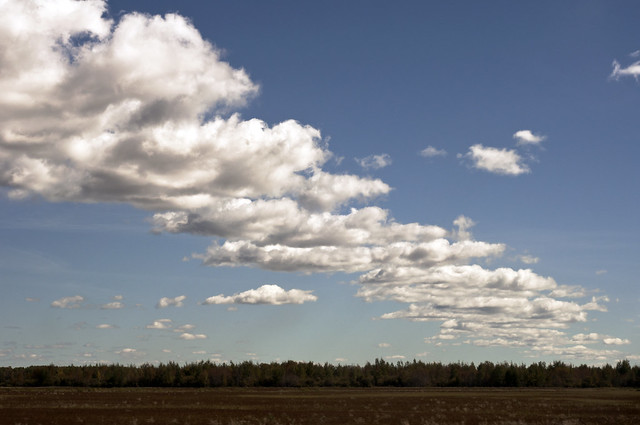Some great images here but C Winston Mitchell's is an absolute standout, a very impressive image.
Some of my 'big skies'
A 3 shot portrait format sunrise pano from the 1DsMkII & 24-105 lens, taken 26 June 2010 from just up the road. I can see these trees from my ‘photo window’ which has the flyscreen removed, but if I get off my bum and toddle up the road I get this much better aspect!
 Fire in the Sky
Fire in the Sky by
Photography by Odille, on Flickr
Approaching storm front, again, a pant up the road (opposite side this time) to grab 40 or so shots of this behemoth advancing. And we didn't get one drop of rain out if it!
 Storm front over Terranora Jan 2010
Storm front over Terranora Jan 2010 by
Photography by Odille, on Flickr
Lake Pukaki (south Island) NZ and the crescent moon at dawn - shot from my Panasonic Lumix FZ35 taken on my last trip to NZ (May 2010)
 Lake Pukaki & dawn moon
Lake Pukaki & dawn moon by
Photography by Odille, on Flickr
I was moseying around feeding the pussies about 5.30 this morning (3 Sept 2010) and a bit of nice colour was coming up, so I changed lenses to the 50-110 and took a couple out the window, then I thought this was really starting to shape up and hurried downstairs for a better view, but even I didn't expect it to get this spectacular.
 Sunrise
Sunrise by
Photography by Odille, on Flickr
I did some research into the interesting phenomenon of seeing the sun in the sea before it actually pokes its 'nose' over the horizon. From wikipedia:
Sunrise is the instant at which the upper edge of the Sun appears above the horizon in the east. Sunrise should not be confused with dawn, which is the (variously defined) point at which the sky begins to lighten, some time before the sun itself appears, ending twilight. Because atmospheric refraction causes the sun to be seen while it is still below the horizon, both sunrise and sunset are, from one point of view, optical illusions.
As sunrise and sunset are calculated from the leading and trailing edges of the sun, and not the centre, the duration of “day” is slightly longer than “night”. Further, because the light from the sun is bent by the atmospheric refraction, the sun is still visible after it is geometrically below the horizon.

















